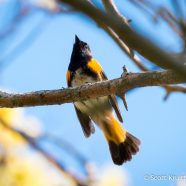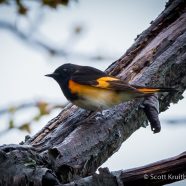American Redstart (Setophaga ruticilla)
The American Redstarts (Setophaga ruticilla) keep on coming! As some of our late-arriving birds like the Blackpoll Warbler are peaking the Redstarts are still pushing through in migration, with others already here building nests. No complaints – we want more of these stunners!
Read MoreAmerican Redstart
Here are a couple more shots from the Noble Proctor BioBlitz Challenge featuring an adult male American Redstart (Setophaga ruticilla). This and many other Redstarts were foraging and singing nonstop on the beautiful spring morning. The species is utterly saturating our region right now with birds that can be seen or heard nearly anywhere you can find trees. I am still seeing mostly males, and I think we have a sizable number of birds yet to come over the next week or two. Scott Kruitbosch Conservation & Outreach Coordinator
Read MoreAmerican Redstart
This is as good of a photo that I could get this morning of the adult male American Redstart (Setophaga ruticilla) seen below, and clearly I need to do better! The conditions were brutal with continued rain and some fog moving in on a very dark day, making the bird stand out even more against the drab surroundings. It was foraging and catching quite a bit while showing those bright wings and that flashy tail to help scare up insects. The weather has been uncooperative for birds as the first few days of the May migratory flight has been difficult with variable winds and precipitation making...
Read MoreAmerican Redstart
Adult male American Redstarts (Setophaga ruticilla) like this one are such a symbol for the season to me. Yes, I can hear their spring song in my mind, especially after seeing so very many in the Chautauqua-Allegheny region this year. Nevertheless, they were usually one of the first and most obvious migrants I saw in late August and September each year when I was a beginning birder, getting me excited for a busy fall migration. Their Halloween tone around the beautifully decaying vegetation helps, too.
Read More







